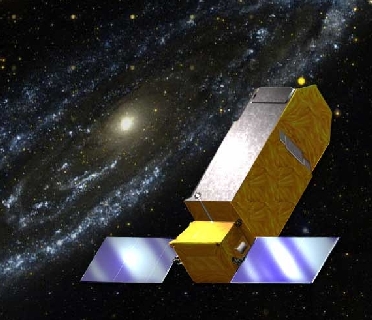

Mission Status Report #81 Star Date: January 21, 2005
FUSE Enters New "Safer" Safe ModeCaption: Graphic of FUSE on-orbit. (Courtesy of FUSE project, JHU.)
The FUSE satellite experienced a significant anomaly on Dec. 27, 2004, that has temporarily suspended science operations. For reasons that are still under investigation, one of our two remaining reaction wheels (the one on the spacecraft "roll" axis) stalled early on December 27, 2004. Efforts to restart the wheel have been unsuccessful to date. However, a significant step has now been taken to keep the satellite in a stable configuration while recovery efforts are undertaken. The original safe mode FUSE entered when the wheel stalled called for orienting the satellite toward the anti-solar direction. The solar arrays were then rotated toward the sun to maintain charge on the batteries. If the satellite could be held in this configuration, it would indeed have been safe. However, this configuration was not always stable against gravitational torques. With the control software on board and only one reaction wheel, there were times when FUSE would wander from the desired position. The spacecraft has been monitored 24/7 since December 27 in order to be prepared to take countermeasures if needed to keep the satellite safe. I am happy to say that as of Jan. 20, 2005, we have successfully established a revised safe mode that should keep the satellite safe without such intensive monitoring and intervention. The new mode is "nadir-pointing," which simply means the long axis of the satellite is always looking "down" (toward the center of the earth). In this configuration, there are almost no gravitational disturbances, and so the configuration remains stable. Sufficient sunlight hits the solar panels on each day-side pass of the satellite to keep FUSE power positive. This is an important step for us. Now that FUSE is in a safer safe mode, we can turn our full attention toward developing and testing revised flight software to allow operations with a single reaction wheel in the control loop. We will also continue efforts to spin the errant wheel in hopes of getting it going again, but the longer we go without success the less likely it seems that this will occur. Special thanks are due to the team at Orbital Sciences Corp., and to our control center staff and JHU Science Operations staff for keeping FUSE safe through the last several weeks. (FUSE did not always choose daytime hours to do its wandering, and in particular seemed to like late nights!) I will post further updates as they are warranted. Stay tuned. Reported by: Bill Blair, FUSE Chief of Observatory Operations
|
